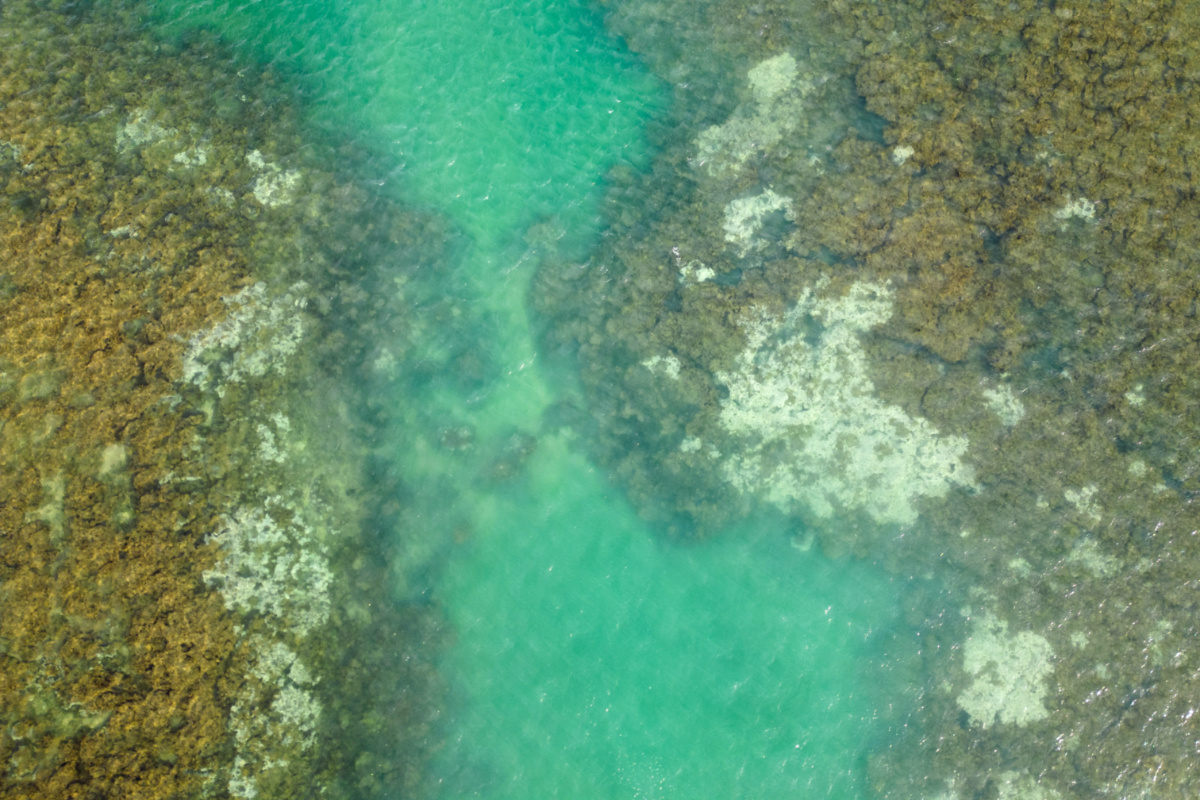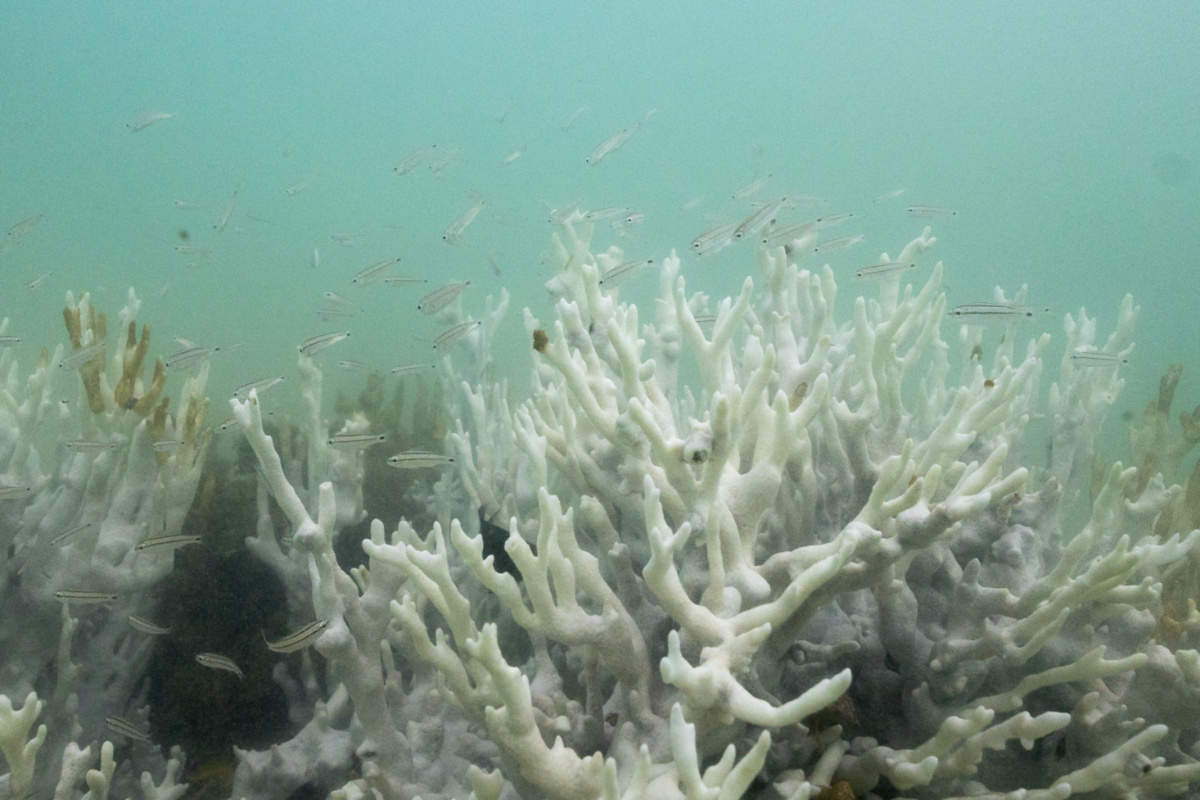Japaratinga, Brazil
Reuters
Brazil is bracing for what may be its worst-ever coral bleaching event as extremely warm waters damage reefs in the country’s largest marine reserve – threatening the region’s tourism and fishing revenues.
With the world’s corals now suffering a fourth mass bleaching event in three decades, some had hoped Brazil’s reefs would be spared as they were during previous global bleaching events,

A drone view shows bleached corals on the reef at the Costa dos Corais, in Japaratinga, in the State of Alagoas, in Brazil, on 16th April, 2024. Brazil is bracing for what may be its worst-ever coral bleaching event as extremely warm waters damage reefs in the country’s largest marine reserve, threatening the region’s tourism and fishing revenues. PICTURE: Reuters/Jorge Silva
Bleaching is triggered by high water temperatures that cause corals to expel the colorful algae living in their tissues. Without the algae delivering nutrients to the corals, the corals begin to starve.
“I have never had anyone call me about bleaching in Brazil,” said Greg Asner, director of the Allen Coral Atlas program that monitors reefs globally by satellite.
But huge swaths of corals have turned bone white along Brazil’s vast Atlantic coastline from the north-east states of Alagoas to Rio Grande do Norte, including the 120 kilometre-long marine park called Coral Coast.
Four scientists monitoring the corals told Reuters that this year was on track to be the worst bleaching on record for Coral Coast and possibly the entire country.
Sea temperatures have smashed records in the last year as climate change intensifies the El Nino phenomenon that normally warms the globe every six or seven years.
Brazil’s reefs are somewhat isolated from those in the more well known Caribbean and have the highest percentage of corals found nowhere else on Earth, including at least seven species threatened with extinction, according to the International Union for Conservation of Nature (IUCN).
Nearly 100 per cent of the corals in some parts of the marine park have been affected, and some have begun dying, said Miguel Mies, research director at the Coral Vivo Institute. A less famous reef off the tip of Brazil near Natal city is being hit even worse, he said.
Divers on the Coral Coast have measured water temperatures of about 33 degrees Celsius, compared to around 27 degrees when corals are most comfortable.
“The bleaching is intense,” Pedro Pereira, coordinator of the non-profit Reef Conservation Project, told Reuters between dives to survey the reef.
“We’re seeing the extinction in front of our eyes of such a beautiful and wondrous ecosystem,” he said.

Bleached coral is seen in a reef at the Costa dos Corais in Japaratinga in the state of Alagoas, Brazil, on 16th April, 2024. PICTURE: Reuters/Jorge Silva
Damage tally
For the coastal town of Maragogi, the technicolor reefs and crystal blue waters of the Coral Coast have helped them build a thriving tourism industry.
Reef tourism generates an estimated 908 million reais ($US175.05 million) each year for Maragogi and the nearby municipalities of Ipojuca and Sao Miguel dos Milagres, according to the conservation charity Boticario Group Foundation.
Thousands of people in the region also work in small-scale fishing, virtually the only economic alternative to tourism, said Claudio Sampaio, who teaches fishing engineering at the Federal University of Alagoas.
This year the catch for octopus, fish and prawns have all declined with the bleaching and high temperatures, adding to the existing problems of pollution and overfishing, said Johnny Antonio da Silva Lima, a 40-year-old fisherman who lives on the Coral Coast.
“It’s an unbearable heat at times,” Silva Lima said.
“We can feel this because we are always walking on the rocks, looking for octopuses mainly, and also fishing with pole lines on the edge of the corals. We feel it on our skin.”
We rely on our readers to fund Sight's work - become a financial supporter today!
For more information, head to our Subscriber's page.
Most of Brazil’s corals live in murkier waters, helping to shield them from the sun, and grow in mass formations that also make them more resilient, according to a 2020 study.
The reefs previously have only been hit by one deadly bleaching event in 2019-2020, which killed up to 50 per cent of the region’s distinct species of brain corals and 90 per cent of its Branching Fire Coral.
The current bleaching is hitting these same species again in Coral Coast park, Mies said.
Corals are animals that have a symbiotic relationship with microalgae that live in their tissue, giving them their brilliant colors that are lost in a bleaching event.
“A bleached coral would be something like if us human beings all of a sudden had transparent skin and organs. So you could see our bones underneath our skin,” Mies said.
Corals can recover if waters cool in time for them to be repopulated by microalgae.
Whether the current bleaching becomes the most severe on record nationally will depend on whether the Abrolhos reef further south is also as damaged as it was in 2020, Mies said.
So far, the Abrolhos reef has experienced limited impact. But with waters expected to remain warm through April, Mies says that could change.
Whatever survives should be studied to determine what traits helped to make it more resilient, as scientists are trying to learn which species might stand up to climate change, said Asner of the Allen Coral Atlas program.
“Those will be the genetic individuals that will propagate and flourish in some future world,” he said.
– With reporting by JORGE SILVA in Japaratinga, Brazil.






